Algarve-South-Portugal.com
The best independent guide to the eastern Algarve
Algarve-South-Portugal.com
The best independent guide to the eastern Algarve
The Eastern Algarve: Sights, activities and things to do and see for 2025
The Eastern Algarve offers a refreshing escape from the bustling tourist centers found elsewhere along Portugal's southern coast. This tranquil region extends from Olhão in the west to Vila Real de Santo António and the Spanish border in the east and encompasses a glorious coastline, rolling countryside, and many traditional towns and villages.
The Eastern Algarve demands a different kind of travel, and offers a rare glimpse of Mediterranean life before mass tourism. Fishermen still mend their nets by hand, salt harvesting follows ancient traditions, and town squares buzz with locals rather than tour groups. This is a region to appreciate nature, embrace authentic Portuguese culture, and savour life at a slower pace.
Our guide will detail the highlights of the Eastern Algarve to help you get the most out of your holiday in this special corner of Portugal. You'll find a comprehensive map showing the location of all these sights halfway through the article.
Cemitério das Âncoras (Anchor Cemetery)
The rusting anchors of Cemitério das Âncoras tell a poignant story of prosperity and decline. These weathered iron anchors-over 100 in total-stand as a haunting memorial to the region's once-thriving tuna fishing industry.
Until the 1960s, a seasonal fishing community thrived on Praia do Barril, using these massive anchors to secure complex nets in the traditional 'armação' tuna fishing technique. When tuna migration patterns shifted and overfishing took its toll, the fishing industry collapsed. The community then placed these anchors in the sand dunes, creating a permanent memorial to their lost way of life.
The Cemitério das Âncoras lies on Praia do Barril and is accessible from the mainland via either a scenic footpath through the sand dune ecosystem or a charming mini train that once served the fishing community.
Related articles: Praia do Barril beach
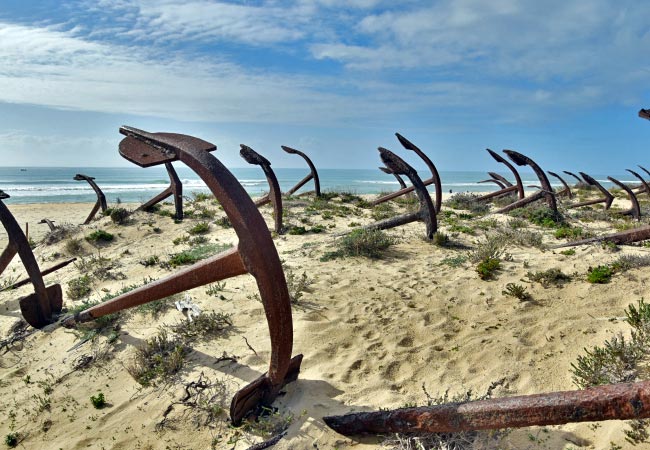
Tavira's Historic Center
Tavira is the gem of the Eastern Algarve, where narrow cobblestone streets wind between whitewashed houses with traditional azulejo tiles, all hinting at the town's rich Moorish heritage.
Standing proudly at the highest point of the city is the medieval castle, with panoramic views across terracotta rooftops and the gentle Gilão River below.
The cooling waters of the river divide the town into two halves, connected by the misleadingly named 'Roman' bridge that actually dates to the 17th century.
The town contains over 37 churches-reputedly one for each day of the month-alongside traditional houses distinguished by their ornate Moorish chimneys and beautiful tiled exteriors.
Tavira offers such a wealth of attractions that it deserves a full day of sightseeing to properly explore and appreciate.
Related article: Sights of Tavira
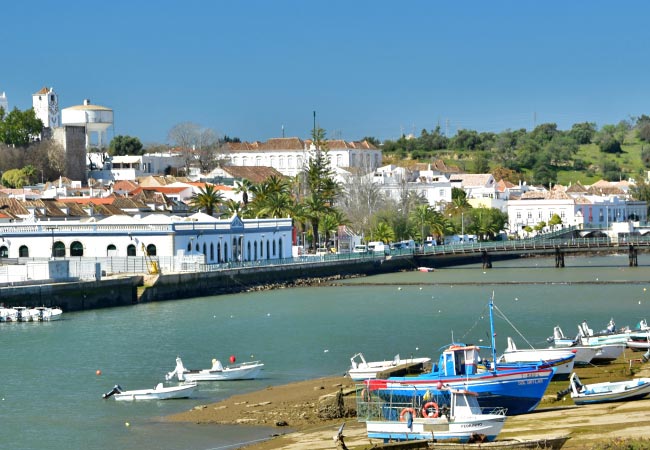
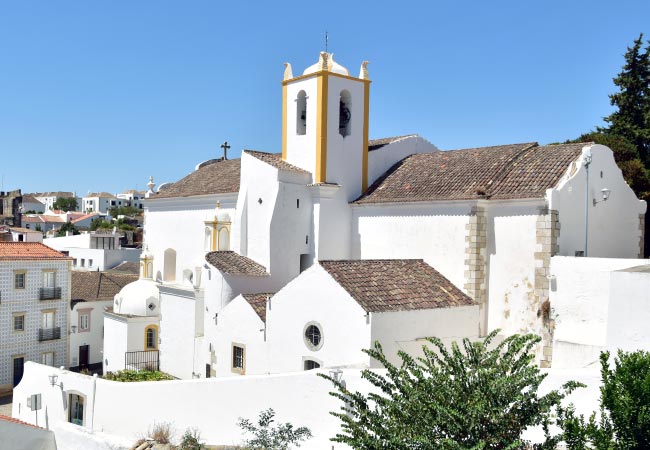
Santa Luzia
This pretty fishing village preserves centuries-old octopus fishing techniques that have remained largely unchanged for generations.
The octopus are caught using "alcatruz" clay pots which they string together and lower to the seafloor. Exploiting the octopus's natural instinct to seek shelter, these traditional traps require no bait and allow selective fishing that has sustained the local marine ecosystem.
Santa Luzia sits quietly along the Ria Formosa lagoon, its harbour filled with the blue and red wooden boats of octopus fishermen returning with their daily catch.
The waterfront is lined with simple family restaurants where locals gather for the village's specialty dishes. Here, octopus is prepared in traditional Algarvian styles - from rich rice stews to chargrilled tentacles finished with local olive oil.
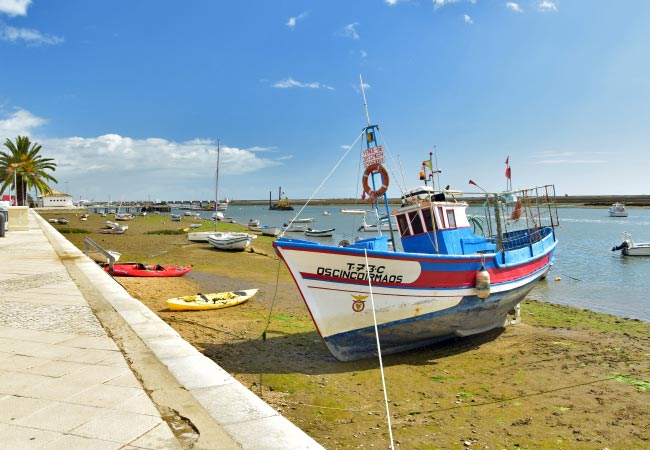
Cacela Velha - Sights of the eastern Algarve
Standing high above the golden sands of Praia da Fábrica, the tiny whitewashed hamlet of Cacela Velha commands what many consider the most magnificent coastal panorama in the Eastern Algarve.
While the village itself might take just minutes to explore, the spectacular view is what draws most visitors here - a sweeping vista of the eastern reaches of Ria Formosa's lagoon system where it meets the Atlantic Ocean.
At the cliff's edge stands the gleaming white Igreja de Nossa Senhora da Assunção (Church of Our Lady of the Assumption). Originally built in the 16th century, this historic structure was reconstructed after the devastating 1755 earthquake that reshaped much of the Algarve coastline. Inside, the church features a simple yet elegant single-nave design, with traditional Portuguese blue and white azulejo tiles adorning its interior.
From the village, a path leads down to Praia da Fábrica, a pristine beach accessible only at low tide, where you can wade through shallow waters to reach stretches of sand often deserted even in high season.

Castelo de Castro Marim
Towering above the Guadiana River, the medieval Castelo de Castro Marim stands as a formidable fortress that played a crucial role in Portugal's defense against Moorish invasion. Built in the 13th century, it later served as the headquarters of the Military Order of Christ. Within its well-preserved walls, visitors can explore ancient cisterns, climb imposing towers, and wander through remains of the governor's palace.
The whitewashed town of Castro Marim itself deserves exploration beyond the castle. Its narrow, cobbled streets wind between traditional Algarvian houses adorned with colorful flowers and intricate chimneys. The 18th-century Fort of São Sebastião sits opposite the main castle on another hill, creating a dramatic twin-fortification system that once completely controlled the river passage.
In the town center, the modest Igreja Matriz (Parish Church) features beautiful blue and white azulejo tiles depicting scenes from the life of the Virgin Mary. Local cafés serve regional specialties, including dishes flavoured with the town's famous artisanal salt, harvested using traditional methods passed down through generations.

Mata Nacional das Dunas Litorais de Vila Real de Santo António
This magnificent coastal pine forest reserve stretches across 440 hectares of dunes and sandy terrain, a living legacy of King Joseph I's visionary 18th century reforestation program designed to halt the inland creep of coastal sands.
Beneath the whispering canopy of maritime pines lies a remarkable Mediterranean ecosystem where sea daffodils burst into golden bloom and hardy coastal plants demonstrate nature's resilience in sandy conditions. Wandering along the network of natural trails that weave through undulating dunes, visitors might spot the region's elusive chameleons changing colour among the undergrowth, rabbits darting between trees, or any of the dozens of bird species that call this protected haven home.
Beyond its natural beauty, this verdant barrier serves a crucial ecological purpose, standing guard against coastal erosion while offering visitors a cool, fragrant sanctuary from the intense summer heat that bathes the Eastern Algarve. The dappled shade and pine-scented forest are crossed by footpaths, that are a joy to stroll on a hot summer’s day.
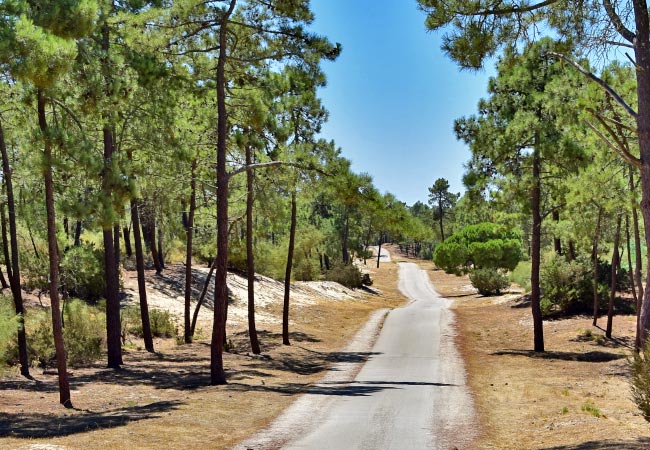
Map of the Eastern Algarve Sights
The following map shows the location of all of the sights detailed in this guide. Please zoom in or out to see the exact locations of them all, and then continue reading below for detailed descriptions of additional Eastern Algarve highlights not yet covered.
Legend: 1) Cemitério das Âncoras 2) Tavira's Historic Center 3) Santa Luzia 4) Cacela Velha 5) Mata Nacional das Dunas Litorais de Vila Real de Santo António 6) Castelo de Castro Marim 7) Parque de Lazer do Perímetro Florestal da Conceição 8) Olive Factory Tavira 9) Vila Real de Santo António 10) Ferry to Spain 11) Olhão 12) Reserva Natural do Sapal de Castro Marim 13) Salinas de Castro Marim 14) Forte de São João da Barra 15) Igreja da Misericórdia 16) Monte Rei Golf 17) Cabanas 18) Limite Zero Zipline (Alcoutim) 19) Cerro da Cabeça Viewpoint 20) Orchard of Flavours 21) Church of Nossa Senhora da Luz
If you would prefer to discover the eastern Algarve with the convenience of a guide, GetYourGuide provides some excellent tours of the region, and these include:
Olive Experience
Hélder Madeira's industrial olive oil factory offers visitors a behind-the-scenes look at large-scale production using the region's abundant olive harvest. While actual production only runs during harvest season from September to November (when the factory hums with activity), tours of the facilities operate year-round.
The tour walks you through the impressive factory facilities where tons of local olives are processed, showing both centuries-old pressing methods and modern machinery that handles commercial volumes. Each visit concludes with a tasting that includes regional delicacies - Tour details here.
Sitio web de Hélder Madeira: heldermadeira.com
Vila Real de Santo António
Strikingly different from other Algarve towns, Vila Real de Santo António follows a perfect grid layout and elegant central plaza designed after Lisbon's famous Pombaline style.
The magnificent Marquês de Pombal Square features Portuguese calçada paving radiating in a sunburst pattern, framed by orange trees and graceful buildings with wrought-iron balconies. Along the palm-lined waterfront promenade, visitors enjoy spectacular views across the Guadiana River to Spain, while the restored 17th-century fortress stands as a reminder of the town's strategic border position and maritime trading history.
The town was actually built in just two years (1773-1775) by order of the Marquês de Pombal as part of his ambitious reconstruction plans following the 1755 earthquake. Its rapid construction served both to assert Portuguese sovereignty at the Spanish border and to support the region's lucrative tuna fishing and salt industries.
The small town is often overlooked but worth of a half day sightseeing.
Related article: Guide to Vila Real de Santo António
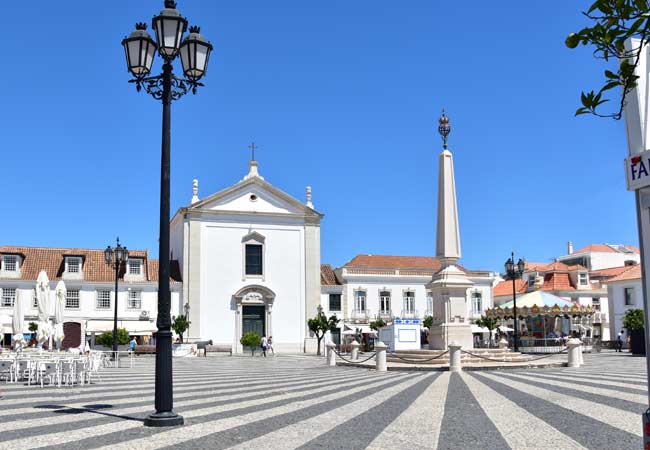
Crossing the Guadiana River to Spain
One of the Eastern Algarve's unique experiences is crossing the Guadiana River to Spain by ferry. From Vila Real de Santo António, regular passenger ferries make the short 15-minute journey across the natural border to Ayamonte in Spain.
This pleasant boat trip offers beautiful views of both countries' shorelines and creates an effortless two-nation day trip. Once in Ayamonte, you can explore its charming plazas, enjoy authentic tapas, and experience the subtle cultural differences just a river's width away. The ferry ride is often combined with exploring Vila Real de Santo António.
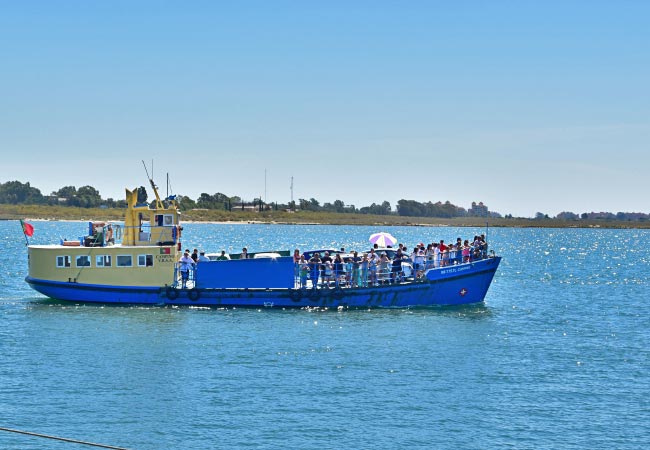
Parque de Lazer do Perímetro Florestal da Conceição
This peaceful 40-hectare forest park sits just 5km from Tavira, offering a shaded retreat from summer heat. The park features four walking trails (1.1-2.3km) where visitors might glimpse fallow deer moving among the shaded forests.
Facilities include picnic areas, a playground, and a bird observation point. The woodland is home to stone pines, eucalyptus, and aromatic plants like rosemary, providing shade and the sweet scents of Mediterranean flora.
Map of the park from Câmara Municipal de Tavira: Trilhos-Parque-lazer.pdf
Olhão
Unlike the resort towns that dominate much of the Algarve, Olhão remains authentically Portuguese with its active fishing industry and Moorish-influenced architecture.
The town's waterfront is defined by two striking red-brick market halls from 1912 that house the fresh fish and local produce markets. Adjacent to these historic buildings, the palm-lined Jardim Pescador Olhanense offers pleasant views across the harbour where colourful fishing boats dock.
Venture into the Barreta and Levante quarters to discover Olhão's most distinctive feature-a labyrinth of narrow alleys where cube-shaped houses with flat roofs (açoteias) create a unique architectural landscape. These flat roofs allowed families a clear view of the harbour, where they could watch for the safe return of loved ones from fishing expeditions. These traditional homes feature external staircases leading to roof terraces once used for drying figs and fish.
At the center of Olhão stands the 18th-century Igreja de Nossa Senhora do Rosário with its Baroque façade and magnificent gilded altar. Nearby, the Municipal Museum is housed in a former merchant's home and displays Roman artifacts excavated from the region.
From Olhão's harbour, passenger ferries make the 15-minute journey to Armona and Culatra islands, where cars are banned and pristine beaches stretch for kilometres along the Atlantic side.
Related articles: Guide to Olhão
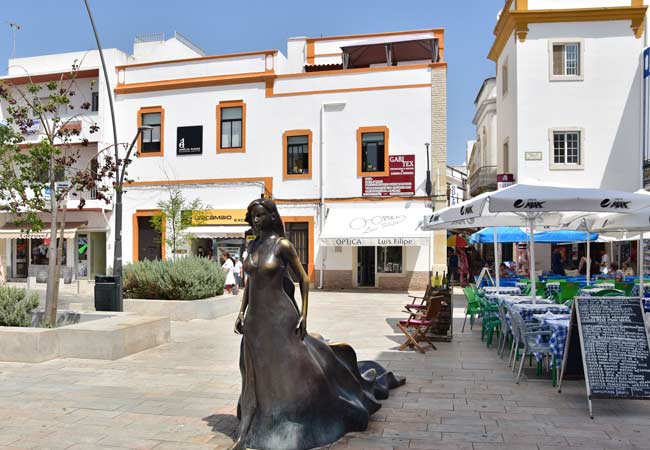
The cube shaped houses in the fishing district
Reserva Natural do Sapal de Castro Marim
This important wetland reserve spreads across 2,000 hectares where the Guadiana River meets the Atlantic. The landscape is a beautiful mix of shimmering salt pans, green marshlands and winding waterways, that are crossed by wooden walkways.
The reserve teems with wildlife - flamingos wade through shallow waters, and spoonbills sweep the shallows for food, while in spring and autumn, migratory species like black-winged stilts, ospreys and glossy ibis add even more life to this already vibrant ecosystem.
Fleur de Sel –Salinas de Castro Marim
The gleaming white pyramids of salt rising from shallow pools create a mesmerizing landscape at the Salinas de Castro Marim. These traditional salt pans have operated since Roman times, preserving ancient harvesting methods that produce some of Portugal's finest fleur de sel-delicate salt crystals prized by chefs worldwide for their complex mineral profile and subtle flavour.
Workers still harvest this "white gold" by hand during summer months, carefully skimming the fragile crystals that form on the water's surface before they sink. This labour-intensive process, unchanged for centuries, yields salt of exceptional purity. Visitors can walk the narrow paths between the crystallization ponds, observe the harvesting process, and purchase artisanal salt products directly from the producers: www.salmarim.com
Igreja da Misericórdia
Often overlooked by visitors rushing between Tavira's castle and riverfront, the Igreja da Misericórdia contains the town's most extraordinary artistic treasures. Its Renaissance portal, carved in 1551, frames an entrance to a compact interior where 18th-century azulejo panels depict the fourteen Works of Mercy in vivid blue and white scenes.
The church's ornate altar showcases magnificent gilded woodwork characteristic of Portuguese baroque style. Built by the charitable Brotherhood of Mercy in the 16th century, this architectural gem represents both artistic excellence and the town's spiritual heritage.
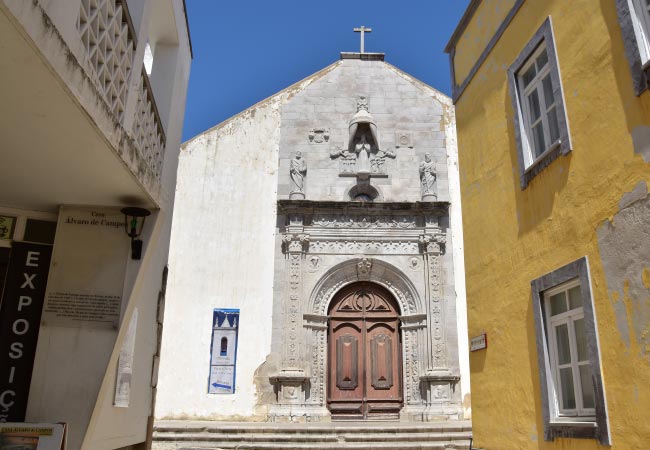
Monte Rei Golf
Widely considered the crown jewel of Algarve golf, this Jack Nicklaus signature course near Vila Nova de Cacela sets the standard for excellence in Portugal. The impeccably maintained fairways wind through rolling hills, umbrella pines and olive groves, with strategic water features and bunkers creating distinct challenges on each hole.
What truly distinguishes Monte Rei is its exceptional service – with limited tee times ensuring an unhurried experience and attentive staff treating each visitor like a member. Though it commands premium green fees, serious golf enthusiasts consider this Eastern Algarve masterpiece a must-play destination.
Cabanas
This charming fishing village sits on the edge of the Ria Formosa, just east of Tavira. Once a sleepy community known only for its fishing traditions, Cabanas has transformed into a delightful resort while maintaining its authentic character.
The heart of the village is its attractive waterfront promenade lined with cafés and restaurants where you can sample fresh seafood while watching colourful fishing boats bob in the water. Across the narrow lagoon lies Cabanas Beach, accessible only by a short water taxi ride, which preserves its natural, undeveloped beauty.
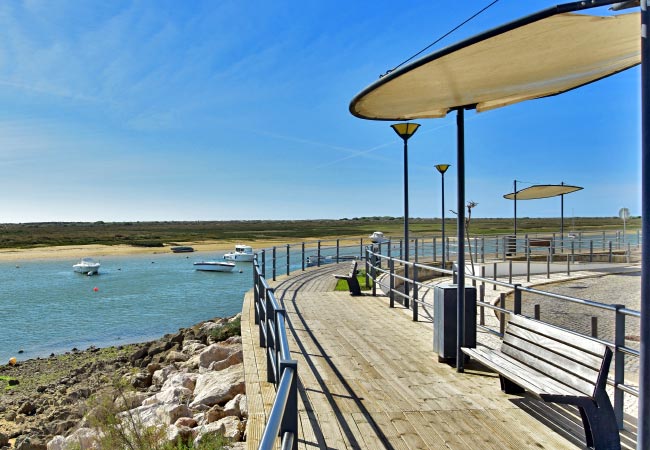
Limite Zero Zipline (Alcoutim)
This thrilling zipline offers a unique international journey, stretching 720 meters across the Guadiana River from Sanlúcar de Guadiana in Spain to Alcoutim in Portugal. As you launch from the Spanish side, you'll soar at speeds up to 80 km/h over the river, crossing not just water but an international border and even a time zone (Spain is one hour ahead). This zipline holds the unique distinction of being the world's only cross-border zipline, literally allowing you to travel from one country to another in less than a minute. - www.limitezero.com
Cerro da Cabeça hike and Viewpoint
Rising 249 meters above sea level, Cerro da Cabeça offers one of the Eastern Algarve's most spectacular panoramic views. On clear days, the vista stretches from Monte Gordo in the east all the way to Quarteira in the west, encompassing coastal towns, the shimmering barrier islands of Ria Formosa, and the vast Atlantic Ocean beyond.
The rewarding 2.5km trail from Moncarapacho guides hikers through fascinating Jurassic limestone formations, past historic lime kilns, and through aromatic Mediterranean scrubland that bursts with colorful wild orchids in spring. The final ascent features 80 stone steps leading to the viewpoint, where an abandoned house and a former fire watchtower stand.
Orchard of Flavours
This botanical garden invites visitors to discover the art of subtropical fruit cultivation in Southern Europe. The Orchard of Flavours functions as both a living laboratory for climate change adaptation and an educational sanctuary dedicated to perennial edible plants from warm climates.
Wander among over 40 exotic fruit tree species thriving in the Algarve's Mediterranean climate-from heritage banana varieties and aromatic citrus to nutrient-rich moringa trees and unexpected edible succulents. The garden demonstrates cutting-edge agroecology practices, including water-conserving irrigation systems, comprehensive composting methods, and regenerative planting techniques. Open Wednesday through Saturday, visitors can explore through self-guided walks or opt for more in-depth private guided tours.
www.orchardofflavours.com
Church of Nossa Senhora da Luz
The Nossa Senhora da Luz church stands as the Algarve's only example of the hallenkirchen style (a German church architecture where all naves reach the same height), setting it apart from typical Portuguese churches of the period. Its three equal-height naves create an unusually open interior space enhanced by elegant rib vaulting.
The exterior features a decorative Manueline south door with grape motifs, a refined Renaissance main portal, and an impressive altarpiece supported by Corinthian columns. The church's pristine whitewashed walls contrast beautifully with grey stone architectural details.
Our most popular guides to the Eastern Algarve


















